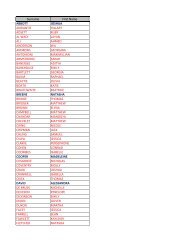EYFS to KS2 Music Skills Overview - Tanglin Trust School
EYFS to KS2 Music Skills Overview - Tanglin Trust School
EYFS to KS2 Music Skills Overview - Tanglin Trust School
You also want an ePaper? Increase the reach of your titles
YUMPU automatically turns print PDFs into web optimized ePapers that Google loves.
Vocabulary &<br />
concept<br />
Knowledge<br />
Beat, melody, orchestra, rest, rhythm, solo, fast, slow, getting faster/slower,<br />
picture score, conduc<strong>to</strong>r, f & p<br />
<strong>Music</strong> IT Groovy <strong>Music</strong> shapes lessons 3-8 (<strong>Music</strong> words, <strong>Music</strong> symbols, Long & short,<br />
Beat, Fast & slow, Sounds and the beat)<br />
PROGRESSION OF MUSIC SKILLS & CONCEPTS<br />
EARLY YEARS FOUNDATION STAGE – KEY STAGE 2<br />
KS1:<br />
<strong>Skills</strong>: Y2<br />
Vocal<br />
Instrumental &<br />
Performance<br />
skills<br />
Creating music<br />
Appraising<br />
& listening<br />
Listening<br />
Reper<strong>to</strong>ire<br />
By the end of this year, children should aim <strong>to</strong>wards being able <strong>to</strong>…. YEAR 2<br />
Sing with a sense of the shape of the melody.<br />
Imitate melody patterns in echoes<br />
Sing a range of simple 1 & 2 part songs from memory<br />
Internalise sounds by singing ‘parts of songs’ in their heads<br />
Perform simple patterns and accompaniments keeping <strong>to</strong> a steady pulse.<br />
Play a 3-note melody on tuned percussion and recorders with some sense<br />
of communication<br />
Echo short rhythms & melodic patterns on tuned instruments<br />
Choose sounds carefully in response <strong>to</strong> a given starting point<br />
Order sounds within simple structures<br />
Create an interpretation of given graphic symbols/scores<br />
Recognise and describe mood changes in music<br />
Recognise the difference between steady beat and no beat<br />
Show the con<strong>to</strong>ur of melodies as moving upwards, downwards or staying<br />
the same<br />
Recognise differences in dynamic levels & changes in tempo<br />
Use sound words or phrases <strong>to</strong> describe selected sounds and how they<br />
are produced<br />
Recognise a song with an accompaniment and one without<br />
accompaniment<br />
Differentiate between the contrasting sections of a song<br />
Listen <strong>to</strong> activities with Groovy <strong>Music</strong> Shapes<br />
World <strong>Music</strong>; <strong>Music</strong> of Singapore; Chinese, Malay & Indian musical<br />
extracts<br />
Benjamin Britten: Young Persons Guide <strong>to</strong> the Orchestra<br />
Baroque recorder concer<strong>to</strong>s <strong>to</strong> show use of recorders



